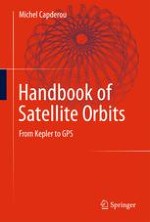
2014 | OriginalPaper | Buchkapitel
1. Geometry of the Ellipse
verfasst von : Michel Capderou
Erschienen in: Handbook of Satellite Orbits
Aktivieren Sie unsere intelligente Suche, um passende Fachinhalte oder Patente zu finden.
Wählen Sie Textabschnitte aus um mit Künstlicher Intelligenz passenden Patente zu finden. powered by
Markieren Sie Textabschnitte, um KI-gestützt weitere passende Inhalte zu finden. powered by